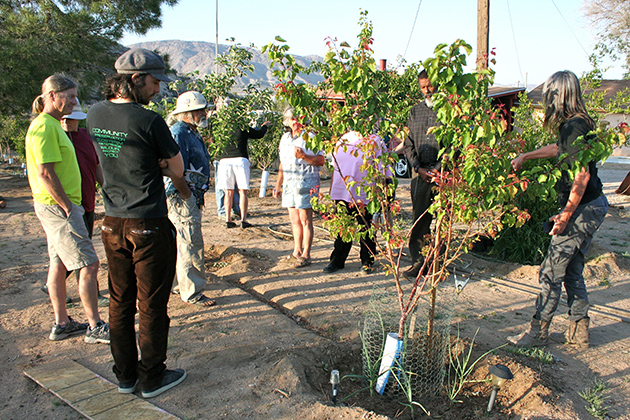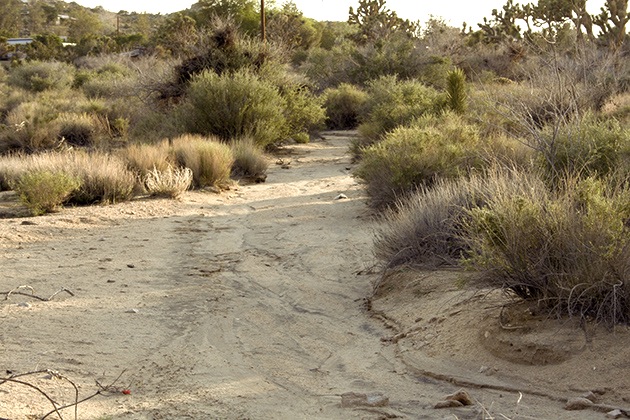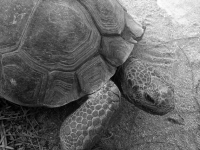Part IV–Transition Joshua Tree Permaculture Meeting

IV. The Meeting
“You’ll have to navigate,” Jill said as she handed me the directions.
We arrived at Hamid’s house at 5:55 for the Transition Joshua Tree Permaculture Group meeting. He greeted us with the warmth of the sand, wearing a safari hat and Hawaiian shirt, standing next to a scarecrow that gave us a gaping look as it stared at us through oversized sunglasses and a mop of blue hair standing on end. I smiled back as I admired its fashion sense: a trench coat layered underneath a pair wading overalls. By the time I set my bag down in the living room where Hamid had already arranged couches and chairs in a large circle for the meeting, the group was ready to begin the tour. An agreement was made at the last meeting to be more punctual.
Outside, we began walking down a long ramp into a greenhouse that Hamid had dug six feet into the ground to keep the temperature steady. Then, we walked through a nursery of mesquite trees and cacti. “Oh, this is a mesquite tree,” I said, realizing the tall mystery tree on Neil’s site was a mesquite.
“You can make a flour out of the mesquite pods. They are 10% protein filled with a type of sugar that is sweet but doesn’t raise your blood sugar. Mesquite is gluten free too—so mesquite is good for people with gluten allergies and diabetes,” explained Tim Delorey, one of the founding members of the permaculture group. “You can also make a syrup by boiling the pods. I brought some mesquite bread you can try later.” The Transition Joshua Tree Permaculture Group began as a project group started by Tim Delorey, Jill Giegerich, Damian Lester and Janet Tucker. Their first moves were to relay information about permaculture as fast and efficiently as possible, which included organizing a hands-on workshop on boomerang swales and designing a mesquite guild. A guild is a group of species that partition resources or create networks of mutual support. The mesquite guild (#4 on this link) is made up of a mesquite tree underplanted with banana yucca, prickly pear, chuperosa, turpentine bush, four wing saltbush, western mugwort, and wolfberry.
As we approached Hamid’s orchard, Janet pointed out the birds of paradise, “A lot of people think they are just weeds, but they are beautiful and are nitrogen fixers too,” meaning they add nitrogen, an essential nutrient to plant growth, into the soil. Janet is a self-described “native plant nerd” and was another one of the founding members of the permaculture group. Her most recent passion is edible succulents, “It makes me feel optimistic. I was feeling a little down about our limitation.” The Mojave is the driest of the dry, getting as little as 2-4 inches of rain per year. So dry, Mojave gardeners dream about the 12-inches Tucson-area gardeners get in the Sonoran Desert. But edible succulents might be the sweet spot for edible, low-water, desert gardens. “First, the Nopales, the edible prickly pear leaves that are available at supermarkets,” Janet elaborated, “Those plants are available now on sale at Home Depot. Their biggest drawback to me is the very tangy flavor, but I’m working on ways to tame it so that people will be more likely to use it as an everyday vegetable. They also propagate very easily. Among the Yuccas, the Yucca baccata or Banana Yucca is about 3 feet tall and wide and produces 5” long fruits on tall stems that taste like yams. This is by far the most xeric plant, as Yuccas are easily killed by too much water. Finally, the Agaves have the Century Agave and the Agave murphyii, both of which were eaten by the original inhabitants. How to process the Agave for food is a little more complex. First of all the plant has to almost flower, which happens after about 10 years! Then there is a complicated procedure ending in baking the core in the ground. Since the Century Agave gets to be 13 feet across, harvesting it was originally a guy activity! Lastly, I discovered that my Sedum Autumn Joy that I had been growing in pots for years is edible.”
In the orchard, the sun’s glow traced the veins of the leaves of white mulberry trees, danced with pollen of the pears, stroked the fuzz of the almonds, soaked the parasitic wasps protecting the apricots, and ignited my memories of the fig trees growing in the cracks of pavement in Greece. I stared at the trees, I stared at the sand, and I knotted my eyebrows. “I put Alpaca manure around them to help them grow,” Hamid demystified, “I have been thinking about putting it through a grinding wheel to get it to decompose faster.”
The group began to discuss different variations of swales that could be used to catch and store water that sweeps by Hamid’s orchard through a wash. Also called an arroyo, a wash is a dry streambed that temporarily or seasonally fills and flows after heavy rain cascade down a canyon. A swale is a broad, shallow ditch that follows the contours of the land and holds water runoff from storms. Generally, it has a mounded berm on the downhill side. Over time, swales fill up with silt and form terraces that can be planted and mulched. A junk mail swale functions as a sponge in the ground that can stay wet for months and slowly release water to nearby fruit trees. It is made by digging a 1-2 foot hole slightly uphill from a tree and filling it with junk mail, paper bags, and phone books. Then, you wet and stomp on them, add in some horse stall bedding, and finally cover them with rocks to hold in the moisture, and leave a gap for an overflow trough. On slopes steeper than 15 degrees, boomerang swales can catch, store, and pattern the flow of water. These arc-shaped berms form basins that direct water to a tree. They are dug in a net pattern, starting at the top of a slope, so each boomerang transfers the water to the next lower row of boomerangs.
At the end of the rows of fruit and nut trees, Hamid opened the door to his well sitting next to gigantic, empty emergency water tanks. “The pH is 8.6 and the alkalinity is 120, which means it is very good water because nothing grows in it,” Hamid said over the crowing of a rooster in the nearby chicken coop. A red, yellow and black pheasant peered out of the chicken wire.
At the end of the tour, Hamid told us about his upcoming inventions. A series of large plastic cargo crates stood like time capsules waiting to be buried. Hamid bought them from the military and had plans to turn them into a pond. Satellite dishes were stacked against his shed which he planned on turning into raised garden beds by setting them horizontally on tractor tires, filling the dishes with dirt and then running a pole through the center so he could make a teepee of netting to keep the bugs or birds out.
After the tour was complete we went inside for the meeting, which included action items, announcements, reports, old and new business, and planning the tour, which will happen next Thursday, May 8 from 4-7pm. The tour will visit the gardens of Janet Tucker, Damian Lester, and Wolf, and is open to the public to join.





Katherine Ball was in residence as our HDTS Scout in Spring 2014.
The HDTS Scout Residency is dedicated to learning more about the people and places that make up our diverse and ever evolving community.
Originally from Detroit, Michigan, Katherine has worked on projects around the world, exploring alternatives to the dominant discourse. Some of these include: bicycling across the US to interview Americans working on small-scale solutions to the climate crisis, coordinating a national day of action to halt business at banks and corporations unduly influencing state laws, living in an off-grid floating island building mushroom filters to clean a polluted lake, and studying the behaviors of various species acting as the ecological counterpart to civil disobedience. An amateur in the best sense of the word, Katherine strives to give more energy to our dreams than our fears.
During her residency, Katherine engaged in a series of in-depth interviews and conversations with high desert residents, focusing on our human impact on the desert landscape. Her book represents a condensed version of those discussions, encompassing water conservation, big solar, wildlife linkages, and asks: what is a sustainable life in the desert?










